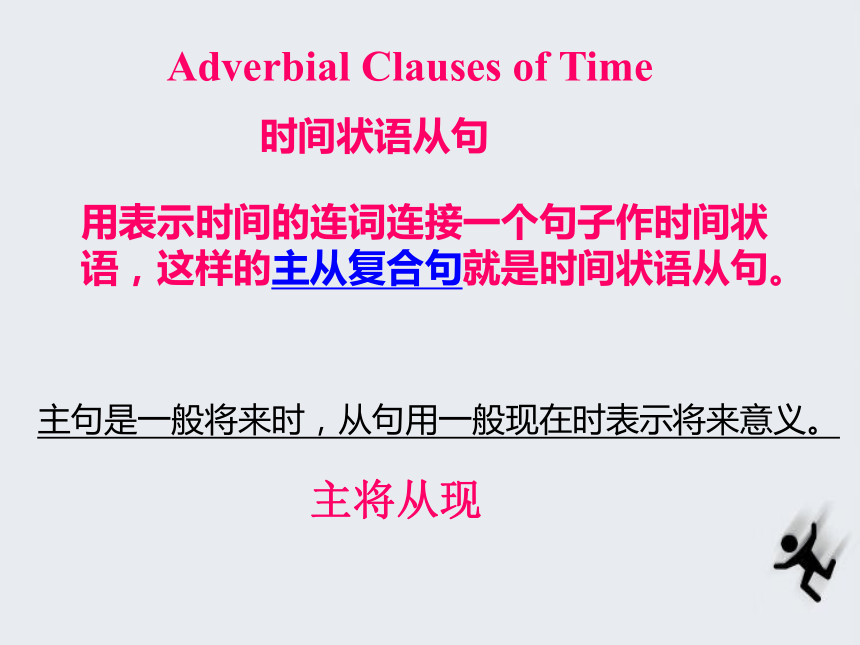
课件45张PPT。Adverbial Clauses of Time 主句是一般将来时,从句用一般现在时表示将来意义。 主将从现时间状语从句用表示时间的连词连接一个句子作时间状语,这样的主从复合句就是时间状语从句。01030205Contents连接词04while/when/as一···就···till/until表示时间的名词词组before & since “当……时候” when/ while/ asⅠ1. when ①when引导的从句可用延续性动词也可用瞬间动词; ② 从句动作和主句的动作 可以 同时发生 也可 先后发生When?I?got?to?the?airport, the?guests?had?left.·When I lived there, I used to go to the beach on Sundays. when 特殊用法when 还可做并列连词 连接并列分句, 表示“就在这时“ =at that time 常用结构“be about to… when…” “正打算···,这时··· ···” e.g We were about to leave when he came in.2. while① while引导的从句的动作和主句的动作同时发生 ② while引导的从句必须使用延续性动词 ③ while引导的从句且多用于进行时The doorbell rang while I was watching TV.I met her while I was at school. 3. as① as引导时间状语侧重从句和主句的动作同时发生 ② as引导的从句通常使用延续性动词 ③还强调一动作随着另一动作的变化而变化 译为: “随着, 一边……一边……”As the children walked along the street, they sang happily. As China develops, Chinese is becoming more and more important.As we were dancing,a stranger came in.“当···时候”when/while/as 的区别 1.同时发生 2.先后发生1.延续性动词 2.瞬间动词 延续性动词 同时发生 1. 同时发生多为延续性动词多用于 进行时“随着” “一边···一边”2.一动作随着另一动作的变化而变化用when/while/as完成下列句子。 1. _____ I went into the classroom, he was reading. 2. _____ he was speaking, everybody listened carefully. 3. I was about to go out _____ a visitor came.when While When 4.There is plenty of rain in the south _____ there is little in the north. A. while?? B. as? C. when??? D. so A “一 ··· 就···” Ⅱ1.as soon as+从句 ? I'll telephone you?as?soon?as?I get home. 2.the moment/ minute/ second/instant +从句 The moment I saw her, I cried out. 3.immediately/directly/instantly+从句 Immediately he came, I told him the news. 4. no sooner…than… hardly/scarcely…when…no sooner… than… hardly/scarcely… when…1.主句谓语用过去完成时,从句谓语用一般过去时。 2.当no sooner和hardly/scarely位于句首时,主句要部分倒装。She had no sooner heard the news than she jumped.No sooner had she heard the news than she jumped.He had hardly/scarcely finished the test when the bell rang. 他一完成测验,铃就响。 ( hardly/scarcely… when…) Hardly/Scarcely had he finished the test when the bell rang. He had finished the test.The bell rang. “直到… ...” Ⅲtill/untiltill/until注意:till/until都表示“直到···”可互换,但放在句首时只用untilI waited till/until he arrived.He won’t go to bed till/until she returns.在肯定句中表示“直到···为止” 主句通常使用延续性动词。在否定句中表示“直到···才” 主句通常使用瞬间动词。not···until用法注意: ①“no until”可用于强调句式 ② “not until” 放在句首时,句子部分倒装。强调结构 “it is/was + not until +从句+that +主句”We did not get off the bus until it stopped.① It was not until it stopped tha ... ...
~~ 您好,已阅读到文档的结尾了 ~~

